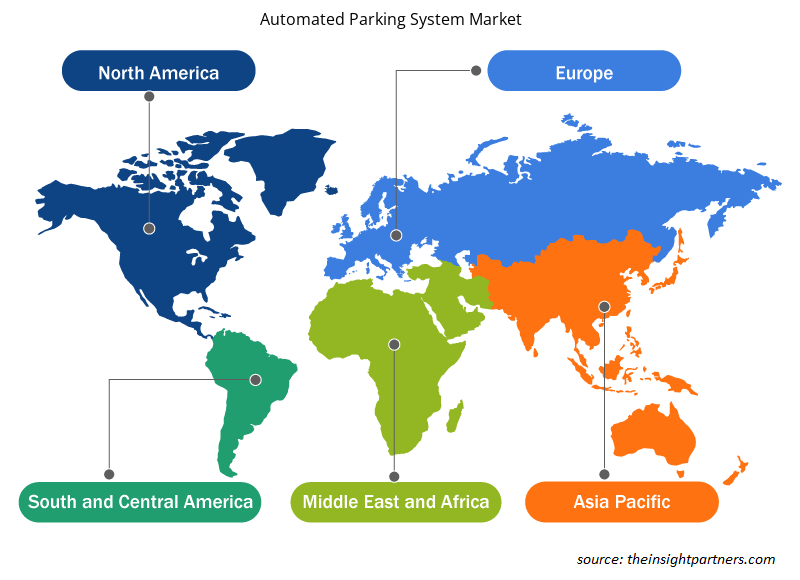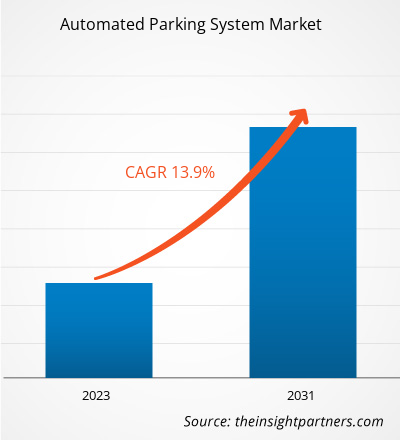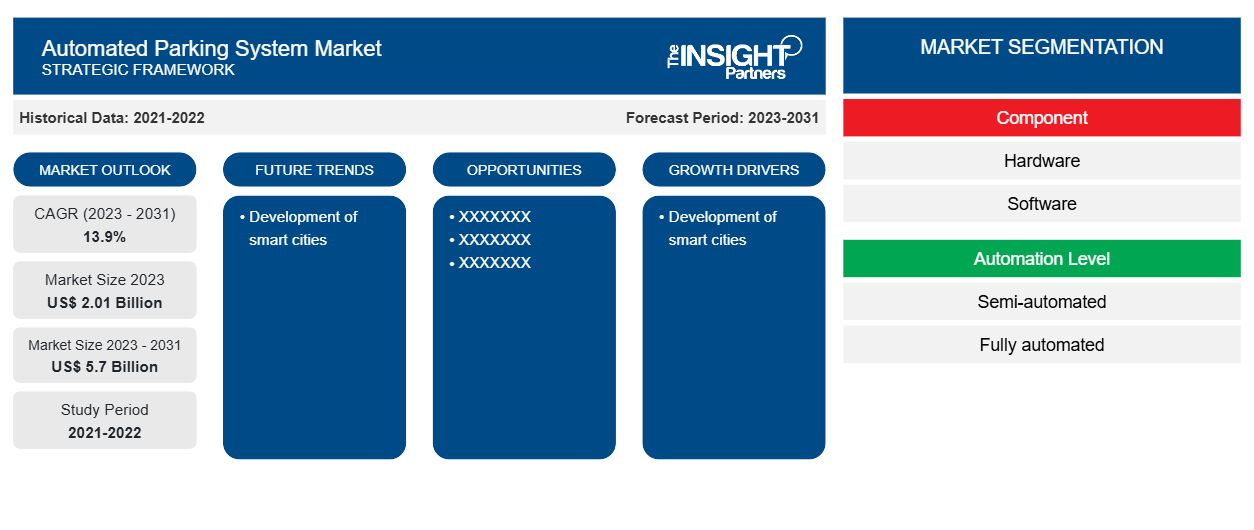Der Markt für automatisierte Parksysteme soll von 2,01 Milliarden US-Dollar im Jahr 2023 auf 5,7 Milliarden US-Dollar im Jahr 2031 anwachsen. Der Markt wird zwischen 2023 und 2031 voraussichtlich eine durchschnittliche jährliche Wachstumsrate (CAGR) von 13,9 % verzeichnen. Die Entwicklung intelligenter Städte dürfte ein wichtiger Trend auf dem Markt bleiben.
Marktanalyse für automatisierte Parksysteme
Eine steigende Nachfrage nach Fahrzeugen und eine wachsende Nachfrage nach nachhaltigen Parklösungen dürften das Marktwachstum in den kommenden Jahren vorantreiben. Darüber hinaus wird erwartet, dass die steigende Zahl von Luxusgebäuden, Wohnungen und großen gewerblichen Parkplätzen die Nachfrage nach automatisierten Parksystemen in den kommenden Jahren ankurbeln wird. Darüber hinaus wird erwartet, dass der Anstieg der Investitionen in technologisch fortschrittliche Parkinfrastruktur das Marktwachstum von 2023 bis 2031 vorantreiben wird.
Marktübersicht für automatisierte Parksysteme
Das Ökosystem des Marktes für automatisierte Parksysteme (APS) ist vielfältig und entwickelt sich weiter. Die Infrastruktur umfasst Hardware-/Komponentenanbieter, APS-Hersteller, Systemintegratoren und Endbenutzer. Wichtige Akteure besetzen die verschiedenen Knotenpunkte des Ökosystems des Marktes für automatisierte Parksysteme. Die Hardware automatisierter Parksysteme umfasst unter anderem Mikrocontroller, Hochfrequenzmodule, Displays, Motortreiber, Gleichstrommotoren, Ultraschallsensoren und Kameraeinheiten. Die Komponentenanbieter liefern das Material zum Bau der Hardware für automatisierte Parksysteme, beispielsweise Stahl, Aluminium und Silizium. APS-Hersteller führen verschiedene Prozesse durch, beispielsweise Design, Montage und Produktion, um Rohmaterialien in fertige Produkte umzuwandeln. Systemintegratoren bringen die Komponentensubsysteme zusammen und sorgen dafür, dass sie effizient arbeiten. AJ Automated Parking Systems Co., Ltd., Unitronic Corporation Inc. und Westfalia Technologies, Inc. sind unter anderem führende Akteure auf dem Markt für automatisierte Parksysteme. Die Unternehmen bieten eine breite Palette von Lösungen für private, gewerbliche und gemischte Anwendungen an. Die zunehmende Abstufung von Parkflächen und die Forderung, mehr Fahrzeuge bequem auf weniger Fläche unterzubringen, dürften für Unternehmen, die in diesen Markt einsteigen möchten, erhebliche Chancen darstellen.
Passen Sie diesen Bericht Ihren Anforderungen an
Sie erhalten kostenlose Anpassungen an jedem Bericht, einschließlich Teilen dieses Berichts oder einer Analyse auf Länderebene, eines Excel-Datenpakets sowie tolle Angebote und Rabatte für Start-ups und Universitäten.
-
Holen Sie sich die wichtigsten Markttrends aus diesem Bericht.Dieses KOSTENLOSE Beispiel umfasst eine Datenanalyse von Markttrends bis hin zu Schätzungen und Prognosen.
Markttreiber und Chancen für automatisierte Parksysteme
Zunahme der Zahl von Luxusgebäuden mit mehr Platz und verbesserten Parkmöglichkeiten begünstigt den Markt
Wirtschaftswachstum, steigende verfügbare Einkommen und veränderte Lebensstile der Verbraucher haben den Trend zu luxuriösen Hochhäusern mit mehr Platz und verbesserten Parkmöglichkeiten ausgelöst. Immobilienprofis, Architekten und Entwickler von Luxusgebäuden profitieren von automatisierten Parksystemen, die ihnen helfen, innovative, funktionale und ästhetisch ansprechende Optionen für Kunden zu schaffen. Kontinuierliche Innovationen und Fortschritte bei einzigartigen Garagendesigns und unterirdischen Einrichtungen treiben das Wachstum des Marktes für automatisierte Parksysteme weiter voran. Diese Systeme können Platz sparen und zusätzliche vermietbare Fläche für luxuriöse Wohn- und Gewerbeprojekte verfügbar machen, was die Gewinne der Entwickler weiter steigert. Wachsende Bedenken hinsichtlich Gesundheit und Wohlbefinden haben die Nachfrage nach Grünflächen in Luxuswohnungen erhöht. Der Trend zur Reduzierung von Parkplätzen kann genutzt werden, um grünere städtische Umgebungen zu entwickeln.rentable area available for luxury residential and commercial developments, further increasing profits for developers. Growing concerns about health and well-being has increased the demand for
Robotergaragen und Roboterparken
Mit Robotern ausgestattete Werkstätten werden in den nächsten Jahren voraussichtlich immer beliebter, da sie Fahrzeuge sicher und platzsparend lagern und abholen können. Es wird prognostiziert, dass bis 2050 etwa 89 % der Bevölkerung der Vereinigten Staaten in städtischen Gebieten leben werden, was das Land zu einem dicht besiedelten Land macht. Da Großstädte einen Mangel an Parkplätzen melden, erfreuen sich automatisierte Garagen aufgrund ihrer Möglichkeiten zur Raumverwaltung rasch zunehmender Beliebtheit. Roboterparksysteme machen menschliches Eingreifen überflüssig, um Fahrzeuge in dicht gedrängte Kabinen zu bringen, und erfordern ausreichend Platz, damit sich Roboter bewegen können. Dicht besiedelte Länder übernehmen daher schnell Roboterparksysteme. Unternehmen, die automatisierte Roboterwerkstätten anbieten, legen größeren Wert auf die Verbesserung und Steigerung der Effizienz und Nachhaltigkeit von Transportsystemen.
Segmentierungsanalyse des Marktberichts für automatisierte Parksysteme
Wichtige Segmente, die zur Ableitung der Marktanalyse für automatisierte Parksysteme beigetragen haben, sind Komponente, Automatisierungsgrad, Plattform und Endbenutzer
- Basierend auf den Komponenten ist der Markt für automatisierte Parksysteme in Hardware und Software unterteilt. Das Hardwaresegment hatte im Jahr 2023 einen größeren Marktanteil.
- Nach Automatisierungsgrad ist der Markt in halbautomatisch und vollautomatisch segmentiert. Das vollautomatische Segment hatte im Jahr 2023 den größeren Marktanteil.
- In Bezug auf die Plattform ist der Markt in palettierte und nicht palettierte unterteilt. Das palettierte Segment hielt im Jahr 2023 einen erheblichen Marktanteil.
- Nach Endnutzern ist der Markt in Wohn-, Gewerbe- und Mischnutzung segmentiert. Das gewerbliche Segment verzeichnete im Jahr 2023 den größten Marktanteil.
Marktanteilsanalyse für automatisierte Parksysteme nach Geografie
Der geografische Umfang des Marktberichts für automatisierte Parksysteme ist hauptsächlich in fünf Regionen unterteilt: Nordamerika, Asien-Pazifik, Europa, Naher Osten und Afrika sowie Süd- und Mittelamerika.
Der Umfang des Marktberichts für automatisierte Parksysteme umfasst Nordamerika (USA, Kanada und Mexiko), Europa (Spanien, Großbritannien, Deutschland, Frankreich, Italien und den Rest Europas), den asiatisch-pazifischen Raum (Südkorea, China, Indien, Japan, Australien und den Rest des asiatisch-pazifischen Raums), den Nahen Osten und Afrika (Südafrika, Saudi-Arabien, die Vereinigten Arabischen Emirate und den Rest des Nahen Ostens und Afrikas) sowie Süd- und Mittelamerika (Brasilien, Argentinien und den Rest Süd- und Mittelamerikas). In Bezug auf den Umsatz dominierte Europa im Jahr 2023 den Marktanteil automatisierter Parksysteme. Nordamerika ist der zweitgrößte Beitragszahler zum globalen Markt für automatisierte Parksysteme, gefolgt vom asiatisch-pazifischen Raum.
Regionale Einblicke in den Markt für automatisierte Parksysteme
Die regionalen Trends und Faktoren, die den Markt für automatisierte Parksysteme im gesamten Prognosezeitraum beeinflussen, wurden von den Analysten von Insight Partners ausführlich erläutert. In diesem Abschnitt werden auch die Marktsegmente und die Geografie für automatisierte Parksysteme in Nordamerika, Europa, im asiatisch-pazifischen Raum, im Nahen Osten und Afrika sowie in Süd- und Mittelamerika erörtert.

- Erhalten Sie regionale Daten zum Markt für automatisierte Parksysteme
Umfang des Marktberichts zum automatisierten Parksystem
| Berichtsattribut | Details |
|---|---|
| Marktgröße im Jahr 2023 | 2,01 Milliarden US-Dollar |
| Marktgröße bis 2031 | 5,7 Milliarden US-Dollar |
| Globale CAGR (2023 - 2031) | 13,9 % |
| Historische Daten | 2021-2022 |
| Prognosezeitraum | 2023–2031 |
| Abgedeckte Segmente |
Nach Komponente
|
| Abgedeckte Regionen und Länder |
Nordamerika
|
| Marktführer und wichtige Unternehmensprofile |
|
Dichte der Marktteilnehmer für automatisierte Parksysteme: Auswirkungen auf die Geschäftsdynamik verstehen
Der Markt für automatisierte Parksysteme wächst rasant, angetrieben durch die steigende Nachfrage der Endnutzer aufgrund von Faktoren wie sich entwickelnden Verbraucherpräferenzen, technologischen Fortschritten und einem größeren Bewusstsein für die Vorteile des Produkts. Mit steigender Nachfrage erweitern Unternehmen ihr Angebot, entwickeln Innovationen, um die Bedürfnisse der Verbraucher zu erfüllen, und nutzen neue Trends, was das Marktwachstum weiter ankurbelt.
Die Marktteilnehmerdichte bezieht sich auf die Verteilung der Firmen oder Unternehmen, die in einem bestimmten Markt oder einer bestimmten Branche tätig sind. Sie gibt an, wie viele Wettbewerber (Marktteilnehmer) in einem bestimmten Marktraum im Verhältnis zu seiner Größe oder seinem gesamten Marktwert präsent sind.
Die wichtigsten auf dem Markt für automatisierte Parksysteme tätigen Unternehmen sind:
- ParkPlus Inc.
- Dayang Parking Company Ltd
- Wöhr Parkplatz
- Unitronics Corporation
- Stadtlift
- Lodgie Industries
Haftungsausschluss : Die oben aufgeführten Unternehmen sind nicht in einer bestimmten Reihenfolge aufgeführt.

- Erhalten Sie einen Überblick über die wichtigsten Akteure auf dem Markt für automatisierte Parksysteme
Marktnachrichten und aktuelle Entwicklungen zum Thema automatisierte Parksysteme
Der Markt für automatisierte Parksysteme wird durch die Erhebung qualitativer und quantitativer Daten nach Primär- und Sekundärforschung bewertet, die wichtige Unternehmensveröffentlichungen, Verbandsdaten und Datenbanken umfasst. Nachfolgend sind einige der Entwicklungen auf dem Markt für automatisierte Parksysteme aufgeführt:
- Tesla hat ein neues visionsbasiertes automatisiertes Parksystem für seine neueren visionsbasierten Fahrzeuge auf den Markt gebracht. (Quelle: Tesla, Pressemitteilung, März 2024)
- Die Hyundai Motor Group hat ein Touchscreen-basiertes automatisiertes Mobis-Parksystem (MPS) auf den Markt gebracht. Diese Produkteinführung erweiterte das Produktangebot des Unternehmens und stärkte seine Präsenz auf dem Markt für automatisierte Parksysteme. (Quelle: Hyundai Motor Group, Pressemitteilung, September 2023)
Marktbericht zu automatisierten Parksystemen – Abdeckung und Ergebnisse
Der Bericht „Marktgröße und Prognose für automatisierte Parksysteme (2021–2031)“ bietet eine detaillierte Analyse des Marktes, die die folgenden Bereiche abdeckt:
- Marktgröße und Prognose für automatisierte Parksysteme auf globaler, regionaler und Länderebene für alle wichtigen Marktsegmente, die im Rahmen des Projekts abgedeckt sind
- Markttrends für automatisierte Parksysteme sowie Marktdynamik wie Treiber, Einschränkungen und wichtige Chancen
- Detaillierte PEST- und SWOT-Analyse
- Marktanalyse für automatisierte Parksysteme mit wichtigen Markttrends, globalen und regionalen Rahmenbedingungen, wichtigen Akteuren, Vorschriften und aktuellen Marktentwicklungen
- Branchenlandschaft und Wettbewerbsanalyse, einschließlich Marktkonzentration, Heatmap-Analyse, prominenten Akteuren und aktuellen Entwicklungen auf dem Markt für automatisierte Parksysteme
- Detaillierte Firmenprofile
- Historische Analyse (2 Jahre), Basisjahr, Prognose (7 Jahre) mit CAGR
- PEST- und SWOT-Analyse
- Marktgröße Wert/Volumen – Global, Regional, Land
- Branchen- und Wettbewerbslandschaft
- Excel-Datensatz
Aktuelle Berichte
Erfahrungsberichte
Grund zum Kauf
- Fundierte Entscheidungsfindung
- Marktdynamik verstehen
- Wettbewerbsanalyse
- Kundeneinblicke
- Marktprognosen
- Risikominimierung
- Strategische Planung
- Investitionsbegründung
- Identifizierung neuer Märkte
- Verbesserung von Marketingstrategien
- Steigerung der Betriebseffizienz
- Anpassung an regulatorische Trends























 Kostenlose Probe anfordern für - Markt für automatisierte Parksysteme
Kostenlose Probe anfordern für - Markt für automatisierte Parksysteme